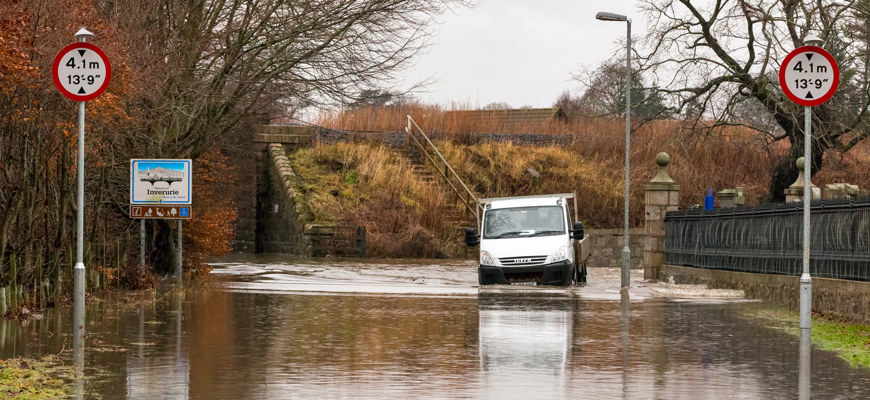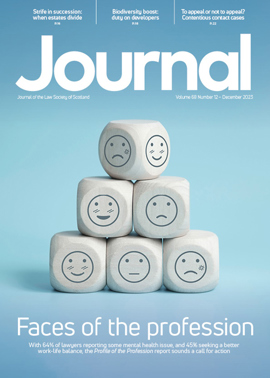Living with water

The weather in Scotland this winter has been unseasonably bad. Storms Ciara and Dennis battered the country during the second wettest February on record, with Edinburgh and Glasgow receiving more than three times the usual February rainfall. That month, the Scottish Environment Protection Agency (SEPA) issued flood warnings for over 40 places around the country.
Rather than being an exceptional event, flooding is becoming an increasing threat in Scotland. Currently there are an estimated 284,000 homes and premises at risk of flooding, according to the National Flood Risk Assessment carried out by SEPA in 2018.
An additional 110,000 properties are projected to become at risk by 2080 as a result of climate change.
Consequences of flooding
When a flood occurs, it can have multiple negative consequences on individuals and communities. A recent report produced by the Centre of Expertise in Waters (CREW) has considered the long-term impacts flooding can have on people. Research was carried out in communities that experienced flooding in the north east of Scotland in the winter of 2015-16, this being some of the worst flooding in living memory (M Currie, L Philip and G Dowds, Long-term impacts of flooding following the winter 2015-16 flooding in North East Scotland: Summary Report, CREW (2020)).
People whose homes had been flooded often had to stay in temporary accommodation for many months while dealing with the repair and refurbishment of their homes. This understandably created a lot of upset and anxiety, as well as involving significant costs, which were not always covered by insurance. Within communities, some are more vulnerable to experiencing long-term negative impacts. The vulnerable include children, elderly and frail people, those living alone and people with pre-existing stressful life circumstances or who have medical conditions.
What is the legal framework regarding flooding?
The legal framework surrounding flooding is contained in the Flood Risk Management (Scotland) Act 2009, which implements the EU Floods Directive (Directive 2007/60/EC) into Scots law. The 2009 Act introduced a co-ordinated approach to sustainable flood risk management, and the Scottish ministers, SEPA, local authorities, Scottish Water and other public bodies have responsibilities in relation to flood risk management.
All these bodies have to exercise their flood risk functions with a view to reducing overall flood risk. SEPA is responsible for producing national flood risk management plans and assessments, while local authorities have to prepare local flood risk management plans. Local authorities must also implement and maintain flood protection measures. However, in Scotland the responsibility for protecting individual properties from flooding lies with the owner of the property.
Increasing property flood resilience
In light of the increasing risk of flood, as well as the responsibility of owners in relation to properties, the Scottish Government committed to promoting property flood resilience in its 2018-19 Programme for Government. A Property Flood Resilience Delivery Group was then set up, which published a Flood Resilience Action Plan in November 2019. This action plan seeks to encourage owners to make changes to their properties in order to make them more resilient to the physical impacts of flooding and lessen the emotional effects on people.
Examples of property flood resilience measures given in the action plan include installing flood doors, moving sockets above floor level, replacing carpets with different flooring, and keeping sentimental or important items upstairs (Scottish Government, Living with Flooding: An action plan for delivering property flood resilience in Scotland (November 2019)).
However, the action plan also states that uptake of these types of measures is currently very low in Scotland. A similar action plan was produced by UK Government’s Department for Environment, Food & Rural Affairs in 2016 (DEFRA, The Property Flood Resilience Action Plan (2016)). This provides some reasons why people do not implement flood resilience measures; they include that “property owners may: not know they are at risk because the property has not flooded recently; not accept that they are at risk because they have not personally experienced a flood event; consider a flood event they have just experienced as a ‘one off’; take the view that ‘only the authorities’ can manage flood risk and there is nothing they can do and/or should do to improve their resilience”.
The CREW report regarding flooding from 2015-16 backs up these grounds by noting that people living in a flood risk area often underestimate the risk and severity of flooding which could affect their area.
How to raise awareness of flood risk?
The question then becomes, how do we raise awareness amongst the general public to allow them to understand flood risk and take action to protect themselves and their properties? Here, the residential conveyancing process provides an opportunity. The Scottish flood resilience action plan recommends that changes are made to the home report to include information related to flood risk and property flood resilience measures. This is echoed by the CREW report, which also recommends that home reports should state if a property is located in a flood risk area, if a property has been flooded and what property flood resilience measures have been installed.
It is important that if this change were implemented, the information provided in the home report will be clear and easy to understand. There could be a traffic light system, which gave an indication of whether the house in question was at a low, medium or high risk of flooding. This could be aligned with the classifications that SEPA has used in the National Flood Risk Assessment, with low likelihood as equivalent to 1 in 1,000 chance of flooding in any given year, medium likelihood as one in 200 chance of flooding, and high likelihood as one in 10 chance.
If the property were at a medium or high risk, potential buyers could obtain a further search in order to get more detail of the flood risk to the property. This would be a similar arrangement to a coal mining report. If a property is in a coal mining area, a report can be obtained from the Coal Authority. In relation to flooding, the data which SEPA and local authorities have collected in relation to their responsibilities for flood risk management could be used to provide this greater level of detail for the potential buyer. This would inform buyers of flood risk, and also encourage both buyers and sellers to consider implementing property flood resilience measures. The Scottish Standard Clauses could then be updated to reflect this new practice, and indeed they have recently been amended to clarify inter alia the existing clause related to flooding, following the case of Anwar v Britton 2019 SLT (Sh Ct) 23.
Flooding cannot be prevented completely, and we will have to adapt to living with water. Thousands of properties in Scotland are at risk of flooding, and this number is only going to increase in the coming years. Due to the wide-ranging effects that flooding can have on individuals and the fact that the responsibility for protecting a property lies with the owner, improvements should be made in raising awareness of flood risk for property owners. The conveyancing process provides a chance for potential buyers to receive this information. Informing the public in this way about the risk of flooding may lead to a greater uptake of property level measures to mitigate the physical and emotional impacts of flooding. This would hopefully contribute to Scotland’s communities being more resilient if and when the waters rise.







